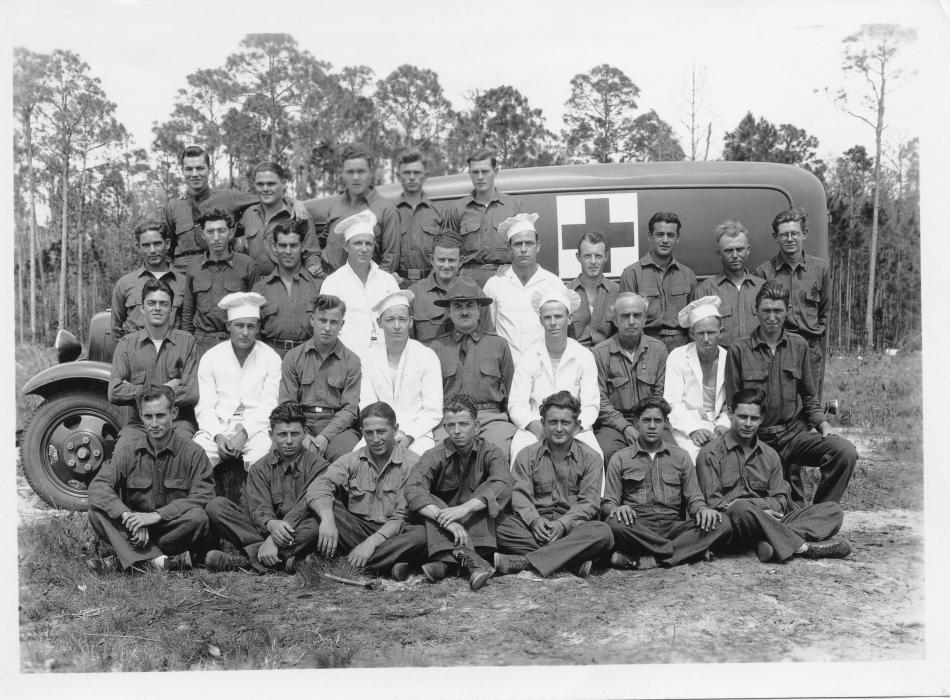
Thanksgiving at a Park in the 1930s

The fourth Thursday of November is the day Americans celebrate Thanksgiving. In 2021, it falls on Nov. 25.
Many families gather for a feast, to watch football and to prepare for holiday shopping the next day.
Most of Florida’s state parks are open for Thanksgiving, as they are every day. When you are planning ways to walk off your extra calories, keep family members busy or create lasting memories, remember your local state park or trail offers great opportunities for getting outside and exploring nature.
Traditional Thanksgiving
Many people reflect on the story of the Pilgrims and the Native Americans sharing food around 1621 after their first harvest in the New World. Gratitude is the focus of that story. They were grateful for the opportunity to set aside differences and share a meal.
Beginning of Florida State Parks
At Florida's state parks, we are grateful for the efforts of the men of the Civilian Conservation Corps who built facilities from 1933 to 1942 at eight parks that became the foundation of our network of parks today.
In the 1930s, the United States was recovering from the Great Depression, when most families were struggling with basic necessities like shelter and food. Employment was scarce as businesses were struggling too.
President Franklin D. Roosevelt established the Civilian Conservation Corps on April 5, 1933, when he signed Executive Order 6101. It was just one month into his presidency, making the CCC one of the earliest New Deal programs. The program had critics, but it was very popular with those who benefited most – unmarried, unemployed men between the ages of 18 and 25 whose families were facing difficulties. Each enrollee signed up for a six-month term.
During the span of nine years (1933 to 1942), between 2.5 and 3 million young men enrolled in the CCC. Of those millions, approximately 250,000 were Black and 80,000 were Native American (Source: The National Archive). The program ended when the U.S. entered World War II.
According to the CCC Resource Page, Florida was home to about 75 camps over those nine years, distributed among forest camps, private forest camps, animal industry camps, biological survey camps and state park camps.
It is estimated that just under 50,000 Florida men were given employment by the CCC, including 45,887 junior and veteran enrollees, 101 American Indians and 3,026 non-enrolled personnel, which included camp officers, supervisors and local experienced men who taught enrollees the skilled trades.

Dots on this Florida map indicate locations of Civilian Conservation camps in 1937.
These eight parks were built or refurbished by the men of the CCC and became the foundation for all the park properties that followed:
- Florida Caverns State Park.
- Fort Clinch State Park.
- Gold Head Branch State Park, which was a camp for World War I veterans. The park name was changed around 1966 to honor Mike Roess, who donated the initial property.
- Highlands Hammock State Park, which includes a CCC museum.
- Hillsborough River State Park.
- Myakka River State Park, which had camps for both white and Black men.
- O’Leno State Park, which was originally a forestry camp.
- Torreya State Park, which had camps for both white and Black men.
Facilities built by the CCC at these parks included ranger stations, cabins, barracks, offices, bridges, flood control devices and more. The crews also cleared trails, created roads, cleaned out caverns, moved buildings from one location to another, and worked on fire control methods.
Each enrollee earned $30 per month, $25 of which was sent home to help support their families. Lodging and food were provided for the enrollees. Some have said the food was good and plentiful and that going to the CCC was like going on vacation from poverty. It’s not surprising that the average weight gain, per enrollee, after three months was 11 pounds.
Frequently, the men were assigned to a camp close to home; however, sometimes they were sent where they were needed. For example, at the Sebring camp at Highlands Hammock, there was a group of 200 men who came from New York and New Jersey to serve.
How did the men enrolled in the CCC celebrate Thanksgiving?
Food was served family-style in the mess hall and enrollees served themselves as much food as they wanted. For most, food was scarce at home where each person learned to take a fair portion, depending upon the number of family members who also needed to eat.

This photograph from 1933 is of men enrolled in Company 451 at the Camp Florida Forest 1 Corps, stationed in Olustee. They served on the mess crew and would have cooked the Thanksgiving meal.
This Thanksgiving menu from 1933 was provided by Georgia Coleman, the wife of camp foreman Lloyd Coleman.
The feast included oyster stew, roast turkey, sage dressing, snow-flake potatoes, candied sweet potatoes and more. Dessert was fresh apple pie a la mode and chocolate cake. It’s interesting to note that cigars and cigarettes and beer are included on the menu.



Joe Toltin was the founder of the Brotherhood of the Ex-CCCers alumni group. He collected memorabilia from camps all over the U.S. When he passed away, his family donated his collection to the Florida State Parks Historic Collections Facility and Archive.
Gratitude and Giving Thanks
Just like the Pilgrims and the Native Americans in 1621 and the men of the Civilian Conservation Corps, we are grateful for the opportunity to celebrate this holiday in 2021. We hope a visit to one of Florida’s state parks is part of your celebration.
This article was published in the Real Florida ℠ Connection, the Florida State Parks e-newsletter. Sign-up to get updates and stories from your state parks the first week of every month.


